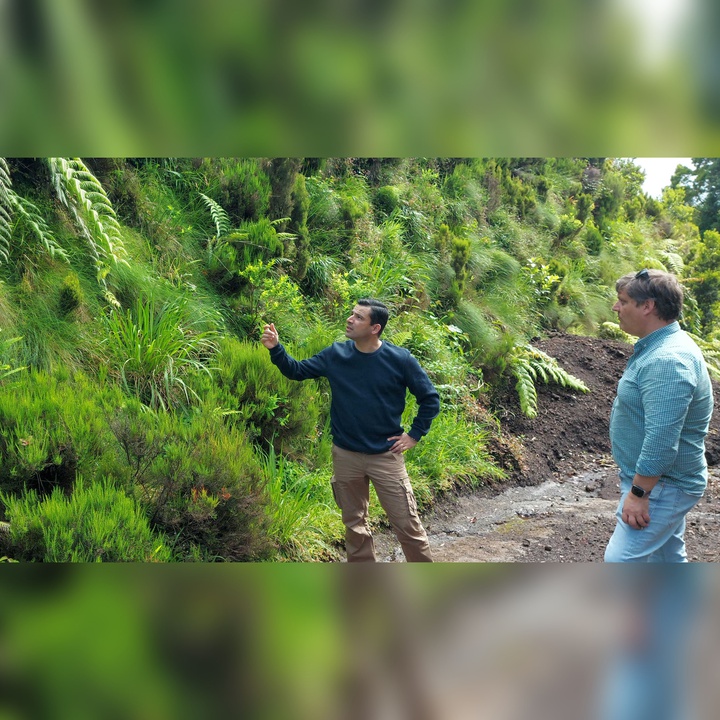Text size:
News

Alonso Miguel visited area where habitat recovery and conservation works are underway in Priolo Lands
June 1, 2023
The Regional Secretary for the Environment and Climate Change, Alonso Miguel, visited the Priolo Lands on São Miguel island, accompanied by Rui Botelho, Coordinator of the Earth Conservation Division of the Portuguese Society for the Study of Birds (SPEA), to follow up the works dedicated to this endemic Azorean bird of acknowledged international importance.
According to Alonso Miguel, "nature conservation and biodiversity preservation are priority intervention areas for the XIII Regional Government of the Azores. In this context, the Region currently has four LIFE Projects underway focusing on this mission, coordinated by the Regional Secretariat for the Environment and Climate Change, notably the LIFE IP AZORES NATURA, which is the first integrated project approved in Portugal and the largest nature conservation project ever created for the Azores, with a budget of 19.1 million Euros.
"It is a fundamental project for the implementation of truly innovative measures to manage priority ecosystems within the Natura 2000 Network, ensuring its ecological recovery, biodiversity monitoring, public use management, environmental awareness and promotion of long-term sustainability. In this context, SPEA is responsible for the management of 160 hectares of Priolo's distribution area with the aim of recovering Laurel Forest, Macaronesian Scrubland and High- altitude peatlands located therein," he explained.
According to Alonso Miguel, "the ecological recovery carried out by SPEA through LIFE Priolo (2003-2008), LIFE Sustainable Laurissilva (2009-2013) and LIFE Terras do Priolo (2013-2019) has contributed to the planting of more than 200 thousand endemic and native plants. It has ensured the recovery of Priolo's natural habitat, through the control of invasive species, reconversion of production forests and interventions carried out at different altitudes and in variable soil conditions, aiming to create shelter conditions and provide food availability for this species."
The government official also mentioned that the efforts undertaken by SPEA, under the LIFE IP AZORES NATURA project, over the last three years, have already contributed to the planting of more than 90 thousand plants. In this regard, he highlighted the interventions in Mata dos Bispos Wood and the recovery actions in streams systems, which are fundamental in the scope of ecological recovery projects of Natura 2000 Network habitats, such as those implemented in Pico da Vara/Ribeira do Guilherme Special Protection Zone.
The Secretary for the Environment also stressed that "one of the major challenges in the Azorean ecosystems concerns the recovery of streams, which have shown high levels of deterioration due to human action, as well as the invasion of exotic plants, resulting in profound changes in hydrological systems and the destruction of their natural structures."
"The application of natural engineering techniques in Macaronesia was, at the beginning of the LIPE IP AZORES NATURA Project, little developed, so it was necessary to conduct tests, aiming to adapt methodologies already validated in Mainland Portugal and internationally, with the use of endemic plant material from the Azores. The results achieved have created the basis for the development of a recovery pilot test. All the information has been compiled in a guidebook dedicated to the use of natural engineering in the Archipelago of the Azores," he said.
"The ecological recovery actions for the conservation of the Priolo species have been carried out for 20 years in the territory, which has provided the opportunity to build knowledge and develop specialised skills, as we have progressed in the different intervention projects, corresponding to a progressive complexity in the characteristics of the terrain and the respective level of demand in the approaches," explained the Secretary for the Environment.
At the end of the visit, which made known the extension of the works dedicated to the protection of this protected species, and included a tour to the Priolo Environmental Centre, the Regional Secretary praised "the committed and excellent work carried out by SPEA in the conservation of Priolo, which resulted in the tripling of its population, now estimated to be around 1.000 individuals. Consequently, its conservation status was upgraded from critically endangered to vulnerable species, according to the Red List of Threatened Species of the International Union for Conservation of Nature (IUCN)."

